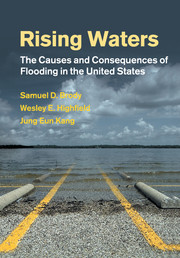Book contents
- Frontmatter
- Contents
- Preface
- Acknowledgments
- Abbreviations
- 1 Introduction: rising waters
- Part I The consequences of floods
- 2 Rising cost of floods in the United States
- 3 Impacts of flooding in coastal Texas and Florida
- 4 National and state flood policy mitigation in the United States
- Part II Planning decisions and flood attenuation
- Part III What are we learning?
- Part IV Policy implications and recommendations
- 12 Conclusions
- References
- Index
2 - Rising cost of floods in the United States
from Part I - The consequences of floods
Published online by Cambridge University Press: 28 April 2011
- Frontmatter
- Contents
- Preface
- Acknowledgments
- Abbreviations
- 1 Introduction: rising waters
- Part I The consequences of floods
- 2 Rising cost of floods in the United States
- 3 Impacts of flooding in coastal Texas and Florida
- 4 National and state flood policy mitigation in the United States
- Part II Planning decisions and flood attenuation
- Part III What are we learning?
- Part IV Policy implications and recommendations
- 12 Conclusions
- References
- Index
Summary
The U.S. is assaulted by a variety of natural hazards every year, totaling tens of billions of dollars in direct damages. Hurricanes along the coasts, earthquakes in California, blizzards in the Midwest, tornadoes, wildfires, and drought are just some of the hazards contributing to persistent, economically damaging adverse impacts. What is virtually unknown and rarely discussed in the public domain is that among all natural hazards, floods pose the greatest threat to the property, safety, and economic well-being of local communities across the nation. While these events rarely make the national news for their drama and intensity, in total, economic impacts from floods alone are estimated in billions of dollars each year (ASFPM, 2000; Pielke, 1996).
Floods have always plagued metropolitan areas in the U.S. because cities tend to be located along major river bodies and in coastal areas for better access to commerce. But, a casual glance at any flood dataset shows that the problem is getting worse, despite the fact that Americans have steadily moved out of urban centers into sprawling suburban environments. For example, data from SHELDUS show that the number of floods per year has increased sixfold, from an average of 394 floods per year in the 1960s to 2444 in the 1990s. This dataset also reveals that floods in the 1960s caused approximately $41 million of property damage a year compared with over $378 million dollars a year in the 1990s (inflation adjusted to 1960 dollars).
- Type
- Chapter
- Information
- Rising WatersThe Causes and Consequences of Flooding in the United States, pp. 11 - 30Publisher: Cambridge University PressPrint publication year: 2011



